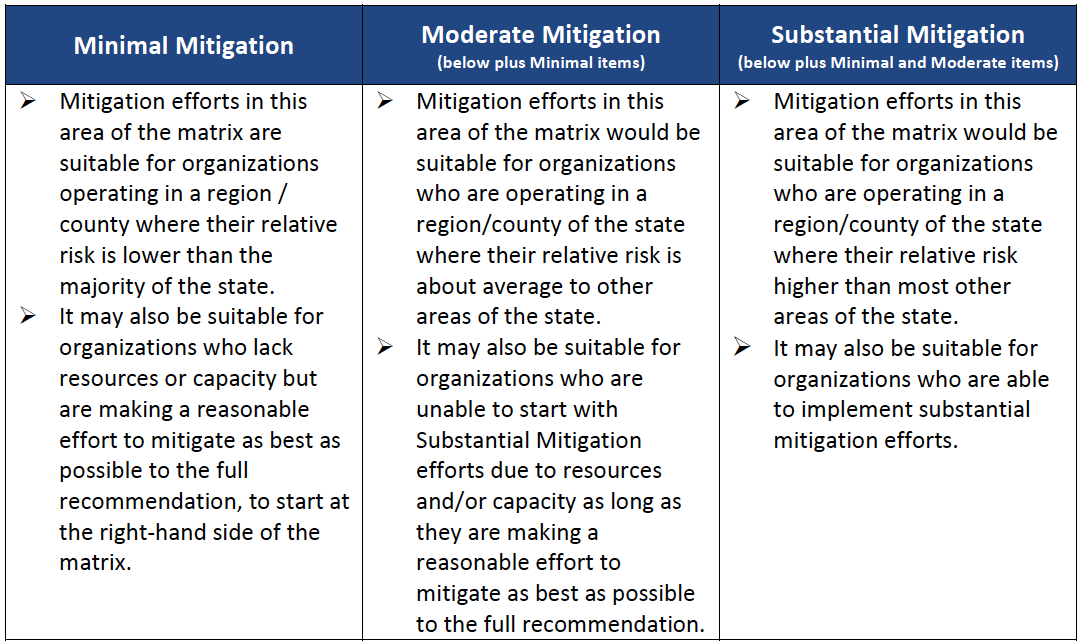In early May, the Central Indiana Corporate Partnership (CICP) released the Safe Return to Work for Indiana’s Manufacturing, Logistics and Warehousing Sectors playbook, a comprehensive guide to how Indiana’s advanced manufacturing and logistics (AML) communities can best bring their employees back into the workplace. The playbook was made in collaboration with key stakeholders like Cummins, the Office of the Governor, the Indiana Economic Development Corporation, the Indiana Department of Labor, and the Department of Workforce Development. It was also built with the help of Energy Systems Network (ESN) and Conexus Indiana professional staff.
The playbook gives dozens of recommendations for a safe, healthy AML workplace. Below, we have listed six important takeaways from the playbook, and you can download the full document here.
Before you form a plan, ask yourself these questions.
If you want to re-open your facility and bring your workers back into contact with each other, there are a number of questions you should answer:
- Have you put COVID-19 health and safety mitigations into effect for the health and safety of your employees throughout the workday, including, as necessary, transport to and from your facility?
- Do you have reasonable, ongoing demand for your product/service?
- Do you have ample supply of incoming production materials to support your manufacturing operations at a reasonable level?
- Have executive orders that have halted your operation during the COVID-19 crisis been lifted, or have you been provided with a waiver as an essential business?
If you cannot answer “yes” to all four of these questions, please reconsider whether it is the best interest of your AML business or your workers to reopen.
Determining the risk factors for your area will establish the intensity of your mitigation.
The playbook’s recommendations are divided by mitigation levels due to the varying severity of cases in different counties.

To determine your mitigation level, take these steps:
- Determine your local confirmed case count/COVID-19 infection rate.
- Determine your regional/local case-fatality rate (confirmed deaths/total confirmed COVID-19 cases).
- Understand your local hospital and community health network situation with respect to COVID-19 (overwhelmed and overcapacity, capable of handling new COVID-19 cases, etc.).
Employee screening should become standard.
Basic employee screening can have a large impact on an AML business. In order to be considered safe and be granted entry into the workplace, an employee must meet three criteria:
- Have you been notified that you have come into contact with a positive COVID-19 case within the past 14 days?
- In the last 10 minutes, have you measured your body temperature with an oral or infrared thermometer?
- Is your body temperature more than 100.4 degrees Fahrenheit (38 Celsius), or do you have any signs of a fever?
Employees that fail to meet these criteria should be asked to remain home, thus eliminating contamination risk from the workplace.
While AML work environments present challenges to social distancing, methods have been determined.
Utilizing distance to reduce the risk of infection is the basic concept behind social distancing. But not all AML operations are currently suitable to add six feet of distance between operations or every employee on the floor. Here are some potential useful mitigation strategies that might be implemented:
- Engineered solutions which change the layout of the operations such that proper distance can be created between and among employees.
- Utilization of temporary barriers to create the necessary separation to eliminate transmission of droplets.
- Design and development of simple tools which help extend distances between and among operators.
- Utilization of administrative controls such as certified and approved PPE (e.g., face masks, face shields, gloves, etc.).
- Implement effective disinfecting/cleaning processes and frequencies to ensure proper wipe down of stations before and after start-up.
- Close all common areas where feasible, along with meeting rooms.
Staggered schedules are effective for multiple preventative measures.
A staggered schedule policy, which requires workers to be present in the facility at differing times or days than other employees, prevents employees from being crowded in common areas, entry and exit points, and on production floors. This serves to not only limit the amount of contact with fellow employees, but will also help to maintain the cleanliness of the facility.
Limiting the number of employees that come into work at any given time also limits the amount of exposure they are at risk to while traveling to work. If an employee previously traveled to the facility five days a week, but now travels only three days, that is two fewer opportunities to be exposed while traveling.
Shipping and receiving is crucial to an AML business, but presents unique challenges.
Shipping and receiving can be one of the more challenging areas to manage during a pandemic. It is difficult to determine appropriate mitigation strategies that enable goods to keep moving. The playbook makes the following recommendations for AML businesses, while keeping safety and productivity in mind:
- Ensure proper screening should suppliers/delivery personnel be allowed onsite.
- If drivers are allowed inside the building post-screening, consider creating a separate room where drivers can wait. Define how many outside visitors may occupy this room and utilize social distancing in the room if more than one person is allowed in at one time.
- Organize the shipping, receiving, and sorting area in an effort to maximize social distancing. If that is not possible, use appropriate PPE.
- Ensure that proper disinfectant materials are available for operators.
- If there is an opportunity to eliminate paperwork and move to digital processes, you can reduce the need for many of the above mitigation actions.
These recommendations are only a fraction of what is offered in the Safe Return to Work playbook. To read all the recommendations for a safe, healthy AML workplace, download the playbook here or read it in its entirety below.
Safe Return to the Workplace for Indiana_CICP April 2020